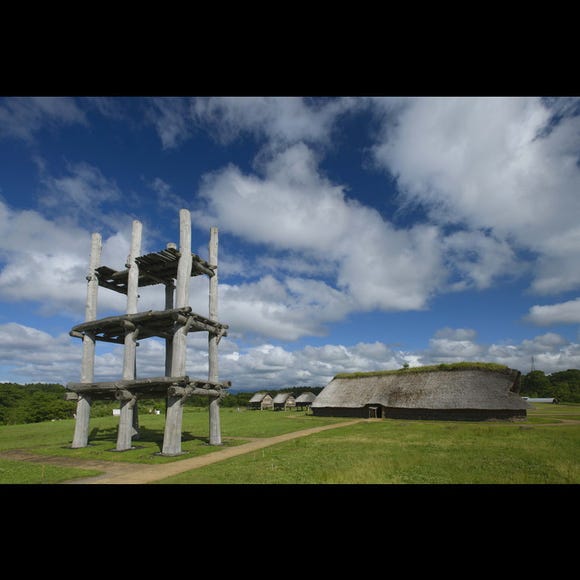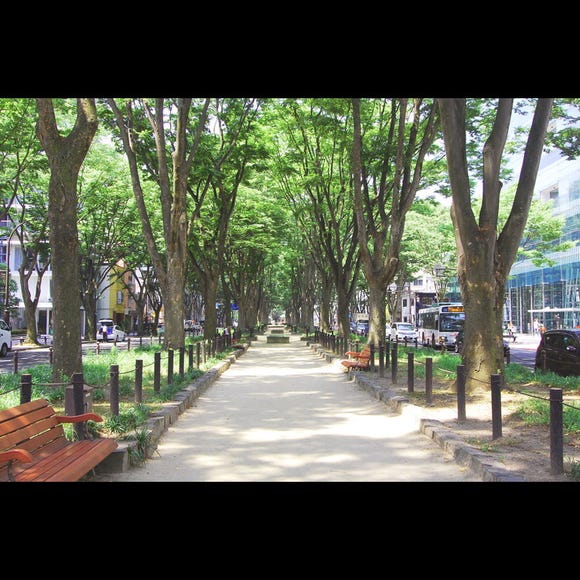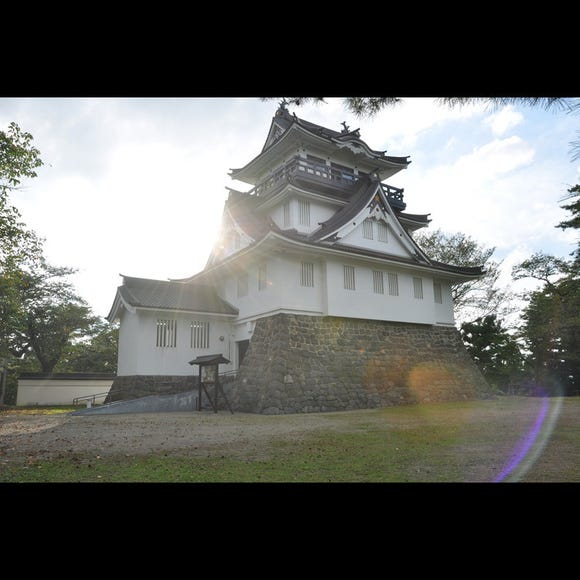
The Akita Kanto Festival, held annually from August 3-6 in Akita City, is one of the Three Great Festivals of Tohoku and enlivens Japan's northeastern region with its vibrant celebrations.
This festival features thrilling acrobats balancing 12-meter bamboo poles on their palms and hips. Around 280 of these poles, adorned with 10,000 golden lanterns, light up the night sky in a mesmerizing display.
Here, we share the history and highlights of the Akita Kanto Festival, as well as attractions in the surrounding area.
Main Photo: Courtesy of the Akita Kanto Festival Executive Committee Secretariat
- Table of Contents
-
- What Is the Akita Kanto Festival?
- 2025 Dates & Schedule for the Akita Kanto Festival
- How to Get to the Akita Kanto Festival from Tokyo
- The Incredible Skills Behind the Kanto Performers
- Highlights of the Akita Kanto Festival
- Is English Available? Language Support at the Festival
- What to See and Do Around the Festival Area
- Where to Stay Near the Akita Kanto Festival
What Is the Akita Kanto Festival?

The Akita Kanto Festival (Akita Kanto Matsuri) embodies the spirit of summer in Akita Prefecture. Recognized as an Important Intangible Folk Cultural Property by the Japanese government, it ranks among the three major festivals in Tohoku, alongside Aomori's Nebuta Festival and Sendai's Tanabata Festival.
Held in the heart of Akita City, the main hub for tourism in the prefecture, the festival runs from August 3rd to 6th, drawing numerous visitors from both Japan and abroad. The city center transforms into a captivating spectacle as approximately 10,000 lanterns light up the streets, creating a mesmerizing atmosphere.
What exactly is a "Kanto"?

The main attraction of the festival is the "Kanto," a thick bamboo pole adorned with up to 46 lanterns. The bamboo pole represents a sheaf of rice, while the lanterns symbolize rice bags, reflecting the festival's wish for a bountiful harvest and prosperity.
The origins of the Kanto date back to the mid-Edo period during the Horeki era (1751-1764). It began as a ritual to ward off summer ailments and drowsiness.
In 1789, during the first year of the Kansei era, a document described a procession with numerous lanterns on long poles arranged in a cross shape, resembling the prototype of the current Kanto Festival.
During the main event, known as the "Night Performance," approximately 280 Kanto poles gather on Kanto Oodori street, about a 15-minute walk from JR Akita Station. Men, known as "sashite," each carry one Kanto pole, showcasing their incredible skills and techniques.

The tallest Kanto pole reaches an astonishing height of 12 meters. The sight of the sashite skillfully transferring the massive Kanto poles onto their palms, shoulders, and waists is truly breathtaking.
2025 Dates & Schedule for the Akita Kanto Festival

The schedule for the 2025 event is as follows. Please check the official website before visiting, as it is subject to change.
- Dates:
- August 3–6, 2025
- Venues:
- Main evening events on Kanto Odori Street; daytime skill showcases at Area Nakaichi Plaza (indoors at CNA Arena Akita if it rains)
- Times:
- ・Evening Performances: Entry at 6:50 PM, performances from 7:15 PM to 8:35 PM, end at 8:50 PM; traffic restrictions from 6:15 PM to 9:30 PM
・Daytime Performances: Preliminary rounds on August 4–5 from 9 AM to 3:40 PM; finals on August 6 from 9:20 AM to 3 PM
- Reserved Seating:
- Group bookings (15+ people) open April 18 at 10 AM; individual bookings (14 or fewer) start May 15 at 10 AM. Reservations available only in Japanese. Visit the official website for details.
If you want to enjoy the power of the Akita Kanto Festival up close, paid seats are recommended. If there are seats available, you can sit down and watch the festival at night. If seats are available, same-day tickets will be sold at the night headquarters, Akita Tourism & Convention Association, play guides, etc.
How to Get to the Akita Kanto Festival from Tokyo

To reach the Akita Kanto Festival from JR Tokyo Station, take the Akita Shinkansen "Komachi" to JR Akita Station, a trip of about 3 hours and 35-55 minutes.
From JR Akita Station, the Daytime Kanto and Night Performance venues are just a 15-minute walk away.
- According to the Japan Meteorological Agency, the average temperature in Akita in August is 25°C (77°F), but can reach around 30°C (86°F) during the day. Evenings can be much cooler.
- Recommended clothes: Breathable T-shirt and jeans for the daytime. Long-sleeved shirt or hoodie for the evening.
- Other items to bring: Sunscreen, sunglasses, a handkerchief or towel, and water to stay hydrated.
The Incredible Skills Behind the Kanto Performers

The Akita Kanto Festival has two main events: the daytime Kanto, an acrobatics competition showcasing performers' techniques, and the nighttime performance, where they demonstrate their skills to the rhythmic beat of drums, flutes, and the chant "Dokkoi Sho, Dokkoi Sho."
The highlight of both events is the performers' remarkable skills, effortlessly handling the 50kg Kanto poles. Techniques include "Nagashi" (flowing), "Hirate" (flat-handed), "Gaku" (forehead), "Kata" (shoulder), and "Koshi" (waist). Knowing these techniques enhances your appreciation of the performers' awe-inspiring abilities.
1. Nagashi (流し) - Gracefully Flowing with the Kanto Pole

The next technique involves supporting the bamboo pole to facilitate smooth transitions. After raising the Kanto pole to a high position, the performer momentarily stabilizes it on the palm of their hand. Then, they adjust their grip by sliding their thumb and index finger about 15cm apart to provide support.
2. Hirate (平手) - Mastering the Flat-Handed Grip

Elevating the Kanto pole high in the air, this fundamental technique showcases the art of raising the pole. The performer holds the Kanto pole in their palm and brings it to a steady stop. Balancing the weight by keeping one hand open and maintaining equilibrium with their dominant arm is the key to mastering this technique.
3. Gaku (額) - Supporting the Kanto Pole with the Forehead

In this grand technique, the performer first receives the Kanto pole in their palm and then carefully shifts it onto their forehead through the gap between their fingers. With both hands stretched wide and a firm stance, they stabilize their balance by firmly planting their feet and engaging their lower body.
4. Kata (肩) - Skillfully Balancing the Kanto Pole on the Shoulders

The technique involves bringing the Kanto pole to a steady stop in the palm and then smoothly lowering it straight onto the shoulder without bending the dominant arm. Maintaining alignment between the supporting leg and the Kanto pole is considered aesthetically pleasing. This technique is known for being easy to master and is often one of the first techniques that performers learn.
5. Koshi (腰) - Mastering the Waist Support

The most demanding technique that requires extensive training. The performer first brings the Kanto pole to a steady stop in the palm of their hand and then carefully shifts it onto their waist through the gap between their fingers. Some skilled performers also incorporate the use of a fan while balancing the Kanto pole on their waist.
Highlights of the Akita Kanto Festival

After the Night Performance, there's a special event called "Fureai Kanto" where you can interact with the Kanto poles. This is a great opportunity to see them up close, feel their size, and take commemorative photos, enhancing your festival experience.
If you have extra time, I recommend watching the "Modori Kanto" (Return Kanto). After the festival concludes, each Kanto pole returns to its respective neighborhood and is showcased to local residents. Unlike the high-energy Night Performance, the "Modori Kanto" offers a more intimate atmosphere with applause and warm cheers from the community.
The lanterns feature the "machi-mon," or the emblem of each neighborhood in Akita City. They depict various symbols representing each neighborhood, as well as patterns and characters that convey wishes for longevity, fertility, and bountiful harvest, reflecting the happiness of the local residents. When observing the festival, be sure to notice the designs on the lanterns as well.

Furthermore, when it comes to festivals, food is an essential part of the experience! During the festival period, the Kanto Oodori Street is lined with the "Kanto Yataimura" (Kanto Food Stalls) on both the east and west sides.
At the Omachi Event Plaza, located just off the main street, the "Local Gourmet Festival" takes place, allowing you to indulge in various local delicacies from different regions of Akita Prefecture.
Treat yourself to specialties unique to Akita Prefecture, such as the famous "Yokote Yakisoba" from Yokote City or the local craft beer "Tazawako Beer" from Senboku City. It's an opportunity to fully savor the gourmet delights that Akita Prefecture has to offer.
Is English Available? Language Support at the Festival

Foreign language support for Akita Kanto Festival is as follows:
Website: English
Pamphlets: English/Chinese (simplified/traditional)/Korean
Staff Information: English
What to See and Do Around the Festival Area

Akita City, where the Akita Kanto Festival takes place, is filled with wonderful tourist spots. We have compiled a list of recommended attractions below to assist you in planning your sightseeing itinerary.
1. Akita City Folk Arts Center (Neburi Nagashi Kan)
The Akita City Folk Arts Center (Neburi Nagashi Kan) is a facility that introduces various folk events in Akita City, including the Akita Kanto Festival. On weekends and holidays from May to October, visitors can enjoy live demonstrations of Kanto poles and even try their hand at Kanto performances.
-
Akita City Folk Arts Center (Neburi Nagashi Kan)秋田市民俗芸能伝承館(ねぶり流し館)
- Address 1 Chome-3-30 Omachi, Akita, 010-0921
- Phone Number 018-866-7091
・Hours: 9:30 AM–4:30 PM
・Admission: 100 yen
・Closed: December 29–January 3
2. Senshu Park
The remains of Kubota Castle, the former residence of the Satake clan, who ruled Akita. It has been transformed into a park and is renowned for its cherry blossoms. The "Osumi Yagura" tower, once used as a lookout, offers a popular vantage point with panoramic views of the cityscape.
-

-
Address
1-1, Senshukouen, Akita-shi, Akita, 010-0876
View Map -
Nearest Station
Akita Station (Ou Line / Akita Shinkansen / Uetsu Line)
5 minutes on foot
- Phone Number 018-888-5753
-
Address
1-1, Senshukouen, Akita-shi, Akita, 010-0876
3. Akita Museum of Art
The museum features permanent exhibitions of works by Shizuki Fujita and European paintings. The main highlight is the monumental mural "Akita's Festivals," measuring 365 x 2,025 cm. Pay special attention to the architectural beauty designed by world-renowned architect Tadao Ando.
-

-
Address
1-4-2, Nakadori, Akita-shi, Akita, 010-0001
View Map -
Nearest Station
Akita Station (Ou Line / Akita Shinkansen / Uetsu Line)
10 minutes on foot
- Phone Number 018-853-8686
-
Address
1-4-2, Nakadori, Akita-shi, Akita, 010-0001
Where to Stay Near the Akita Kanto Festival
There are numerous hotels in the vicinity of Akita Station, ranging from city hotels to business hotels. Here are six recommended places to stay for the Akita Kanto Festival.
The Akita Kanto Festival, where skilled performers showcase their amazing techniques, is a thrilling and captivating event! Experience the breathtaking spectacle firsthand and why not consider visiting Akita this summer?
-

-
Address
Around Kanto Odori, Akita City, Akita Prefecture, 010-0000
View Map -
Nearest Station
Akita Station (Ou Line / Akita Shinkansen / Uetsu Line)
15 minutes on foot
- Phone Number 018-888-5602
-
Address
Around Kanto Odori, Akita City, Akita Prefecture, 010-0000
Text by: Soko Sugawara
(*This article was updated in April 2025. Please check the official websites for the latest information.)
- Area
- Category
*Prices and options mentioned are subject to change.
*Unless stated otherwise, all prices include tax.
Popular Tours & Activitiess
Recommended places for you
-

Ginzan Onsen
Hot Springs (Onsen) & Bath Houses (Sento)
Surrounding Areas Of Yamagata
-

Sannai-Maruyama Site
Village Ruins
Aomori, Hirosaki And Hachinohe
-

Aomori Nebuta Festival
Japanese Festivals (Matsuri)
Aomori, Hirosaki And Hachinohe
-

Zuiganji Temple
Temples
Sendai And Matsushima
-

Jozenji Street
Other Townscapes
Sendai And Matsushima
-

Yokote Park
Parks
Surrounding Areas Of Akita
-
Ad

Just one stop from Haneda Airport! "Truly Japanese!" Food, Fun, and Knowledge Gather at HICityⓇ Enjoy An Electrifying Night at "Japan Night Fever: Haneda Innovation City"
by: Yohei Kato
-

Shopping in Akita: 11 Must-Buy Souvenirs & Where to Shop Near the Station and Airport
by: ShiroKu inc.
-
Ad

Advice from the Experts at Hitohira: Here's How to Choose the Best Japanese Knife
-

Smart Ways to Avoid Crowds and Enjoy a Safe, Comfortable Trip to Myoko, Niigata Prefecture.
-

Niigata Sake no Jin 2026: Guide to Japan's Most Legendary Sake Weekend
-
Ad

Why Fukushima is the Next Big Food Destination in Japan The Foodie Paradise Only 90 Minutes from Tokyo
-

Nebuta, Kanto, and Tanabata – Discover the Three Great Festivals of Tohoku (August)
-

Love Among the Stars: Experience the 2025 Sendai Tanabata Festival Like a Local (Aug 6-8)
by: Guest Contributor
-

Visiting Japan's Miffy Cafe Will Make Your Heart Melt (Photos)
-

Iwate Bucket List: 20 Best Things to Do in Iwate Prefecture For Tourists (Attractions, Food, Activities)
-

10 Must-See Tohoku Festivals: Experience Epic 'Matsuri' in Northern Japan and Discover a World of Tradition
by: Guest Contributor
-

6 Surprisingly Cheap Things in Japan
























